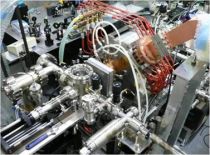Development of Inverse Compton Scattering Soft X-ray Sources Using Photocathode RF Gun
2012-0903-04

- researcher's name
-
about researcher WASHIO, Masakazu Professor (retired)
- affiliation
-
Faculty of Science and Engineering Waseda Research Institute for Science and Engineering
- research field
-
Nuclear engineering,Particle/Nuclear/Cosmic ray/Astro physics,Physical chemistry
- keyword
-
background
In medicine, there are hopes for the development of more compact and high quality X-ray sources.
summary
■Development of Inverse Compton Scattering Soft X-ray Sources Using Photocathode RF Gun
In this research, compact and high quality soft X-ray sources are being developed using inverse Compton scattering, with the final goal of applying them to soft X-ray microscopes for biological observations. Inverse Compton scattering involves the creation of shorter wavelength light through the collision of high energy electrons and long wavelength light, and is the inverse process of the generally well-known Compton scattering. The Washio Laboratory is working on the development of high quality electron beam sources using a photocathode RF gun, as well as researching their applications. This research is one of the experiments for these applications. So far, the laboratory has succeeded in the preparation and detection of soft X-rays using inverse Compton scattering.
application/development
Medical and biological applications, including applications for soft X-ray microscopes for biological observations.
predominance
X-rays derived by the system of the Washio Laboratory are soft X-rays in the energy region called the “water window” of 200-500eV obtained by colliding high energy electron beams derived from a photocathode RF gun and an infrared (IR) laser. Soft X-rays in this region have extremely small absorption by water. On the other hand, there is a lot of absorption by carbon and nitrogen, the component elements of body tissue. Experiments have already verified that soft X-rays may be used for high-resolution soft X-ray microscopes for biological observations that enable the observation of body tissues while they are alive without dehydrating them.
The soft X-ray sources using inverse Compton scattering being developed at the Washio Laboratory are extremely compact compared with general high quality soft X-ray sources, such as those of photon factories. It is expected that as key technologies, their use at mid-size and smaller medical and research facilities would be promoted.
purpose of providing seeds
Sponsord research, Collaboration research, Technical consultation
remarks
Affiliation: Japanese Society of Radiation Chemistry; The Physical Society of Japan; The Chemical Society of Japan; The Society of Polymer Science, Japan; Atomic Energy Society of Japan; RadTech Japan
material
same researcher's seeds
-
 Experiment Using High Quality Beams
Experiment Using High Quality Beams -
 Uncovering the Initial Process of Radiation Chemical Reactions: Pulse Radiolysis Experiment
Uncovering the Initial Process of Radiation Chemical Reactions: Pulse Radiolysis Experiment -
 Maskless Direct Etching Technique Using Focused Ion Beams (FIB)
Maskless Direct Etching Technique Using Focused Ion Beams (FIB)
posted:
2014/05/21



